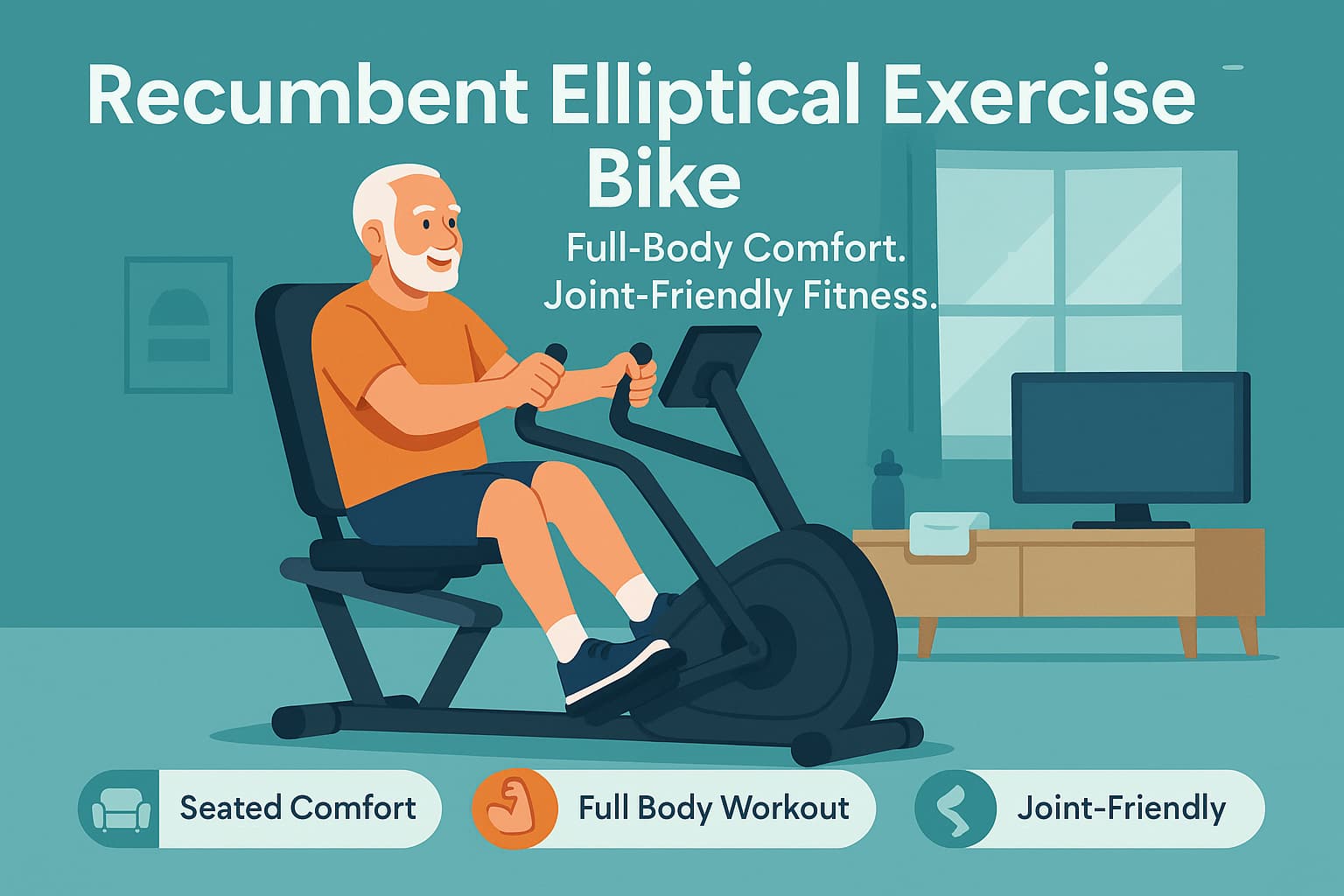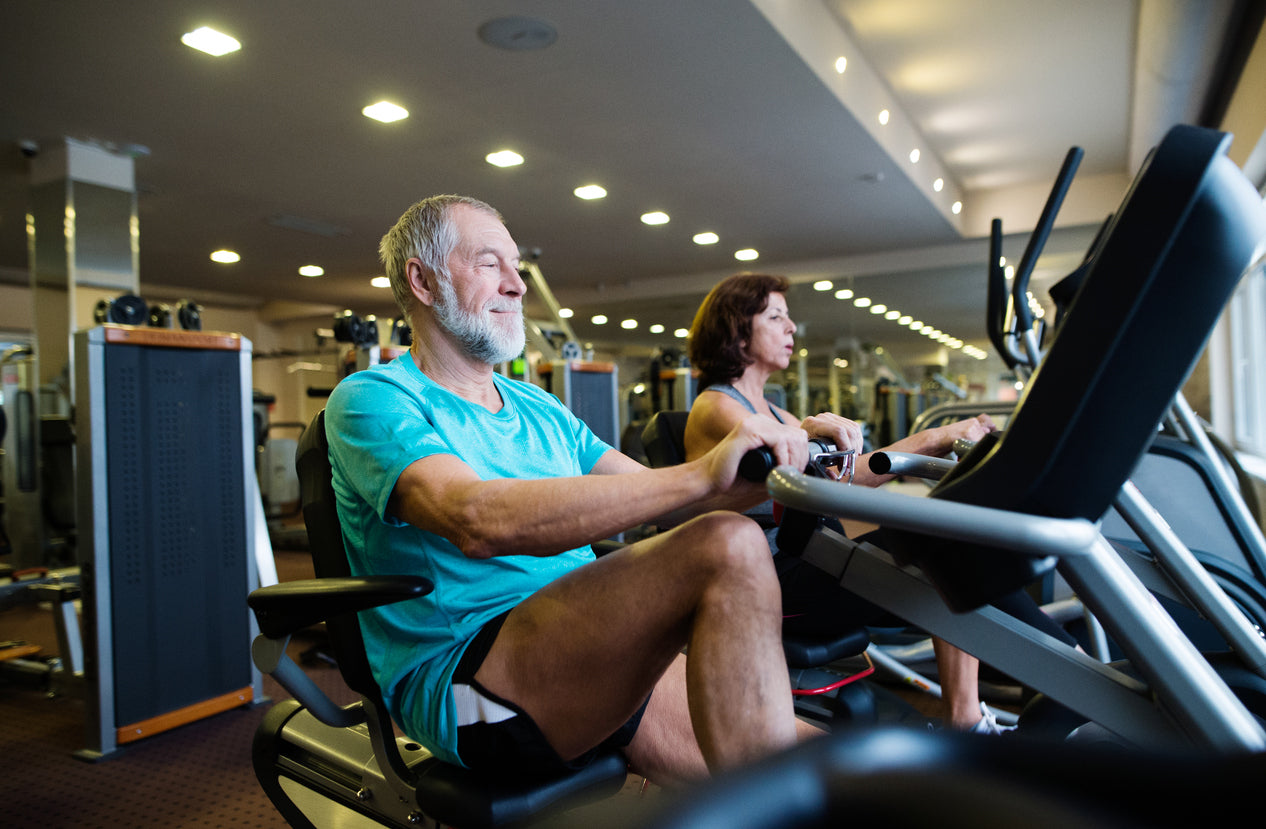As we age, staying physically active becomes even more crucial for maintaining independence, energy, and overall health. Engaging in regular physical activity is especially important for seniors, as it can reduce the risk of chronic diseases, maintain mobility, and improve mental well-being. Yet, many seniors struggle to find an exercise routine that feels safe, comfortable, and sustainable.
That’s where the recumbent bike comes in. A recumbent bike is a type of stationary bike designed for comfort and support. Recumbent biking provides a low-impact exercise option that is joint-friendly and suitable for seniors or those recovering from injury. For older adults looking for a gentle yet effective workout, the recumbent bike offers a unique combination of low-impact movement, ergonomic support, and cardiovascular benefits. It allows seniors to exercise safely from the comfort of home, without placing strain on joints or risking falls.
Why Exercise is Important for Seniors
Exercise is one of the best tools for aging well. For seniors, maintaining an active lifestyle can help preserve strength, mobility, and mental sharpness. According to Johns Hopkins Medicine [1], regular physical activity helps older adults maintain independence, reduce fall risk, and support mental health. It also plays a critical role in managing common age-related conditions such as arthritis, osteoporosis, diabetes, and heart disease.
According to the Centers for Disease Control and Prevention (CDC), adults aged 65 and older should engage in at least 150 minutes of moderate-intensity aerobic activity each week, along with muscle-strengthening activities such as resistance training on two or more days per week. Regular exercise helps:
-
Improve cardiovascular health
-
Boost metabolism and maintain a healthy weight
-
Strengthen bones and improve muscle strength
-
Enhance balance and coordination to prevent falls
-
Support mental health and cognitive function
Source: The National Institute for Aging [2] notes that aerobic exercises like cycling can reduce blood pressure and improve heart health in older adults.
But not all exercises are appropriate for aging bodies. Seniors often need options that are joint-friendly, low-risk, and easy to start [3].
Common Exercise Types and Their Suitability for Seniors
|
Exercise Type |
Examples |
Recumbent Bike Fit? |
|---|---|---|
|
Low-impact cardio |
Recumbent bike, walking, swimming |
✅ Excellent |
|
Strength training |
Resistance bands, light weights |
⚠️ Some limits |
|
Balance training |
Tai chi, yoga |
❌ Not included |
Why Recumbent Bike Workouts Are Ideal for Older Adults

What makes recumbent bikes so uniquely suited for seniors? The key is in their design. With a comfortable, larger seat, supportive backrest, and a reclined body position, recumbent bikes provide excellent support for the lumbar spine and promote proper posture. The pedals are positioned in front of the rider, which reduces stress on the joints and lumbar spine. This ergonomic setup results in less stress on the back, hips, and knees, making it easier to exercise for longer periods without discomfort or risk of injury.
Recumbent bikes beneftis:
-
Stability and safety: The low seating position and wide base make it virtually impossible to tip over.
-
Ease of use: Step-through frames make it simple for users with limited mobility to get on and off.
-
Heart-healthy workouts: You can control resistance levels to stay in a safe heart rate zone while still improving cardiovascular fitness, supporting heart health and overall physical health.
-
Customizable experience: Adjustable seats and handles ensure the right fit for different body types and flexibility levels, allowing you to create a custom workout and simulate riding different terrains.
How to Structure a Recumbent Bike Workout for Seniors
Starting an exercise routine doesn’t mean jumping into intense workouts. For seniors, recumbent bike should start with 10–15 minute low-intensity sessions 2–3 times a week, then gradually increase to 20–30 minutes at a steady pace, adding light resistance or intervals as endurance improves.
Focus on maintaining a comfortable pace, or even a leisurely pace when starting out, where you can still hold a conversation. Maintaining a steady pace is important for safety and effectiveness. This is typically known as “Zone 2” cardio—ideal for fat burning and endurance building. Recumbent bike exercise is a low-impact way to build cardiovascular endurance, making it suitable for beginners, seniors, and those in rehabilitation.
Following the sample plan, your recumbent bike workouts will be effective for improving cardiovascular endurance and overall fitness.
Sample Weekly Workout Plan (Beginner Level)
|
Day |
Time |
Intensity |
Focus |
|
Mon |
10 min |
Low |
Warm-up ride, get moving |
|
Wed |
15 min |
Moderate |
Steady cardio, light sweat |
|
Fri |
12 min |
Low-Moderate |
Confidence and rhythm |
As your strength and endurance improve, you can:
-
Increase ride duration to 20-30 minutes
-
Add resistance intervals (1 minute harder, 2 minutes easy)
-
Ride 4-5 days per week for cumulative health benefits
Rehabilitation-Focused Recumbent Bike Workouts for Seniors
For seniors recovering from injury, surgery, or managing chronic conditions like arthritis, rehabilitation-focused recumbent bike workouts offer a gentle yet effective path back to better health. The recumbent bike’s ergonomic design and reclined seating position provide crucial support, allowing you to exercise without putting undue stress on your joints or back. This makes recumbent bikes an excellent choice for those who need a low impact workout that still delivers real cardiovascular health benefits.
A typical rehabilitation recumbent bike workout plan starts with short, manageable sessions—think 10 to 15 minutes, two to three times per week. As your fitness levels improve, you can gradually increase both the duration and frequency of your bike workouts. The key is to listen to your body and progress at a pace that feels right for you.
Working with a certified personal trainer or consulting your healthcare provider can help you develop a recumbent bike workout plan tailored to your specific needs and goals. Recumbent bikes provide a safe environment to rebuild strength, improve flexibility, and boost cardiovascular health, all while minimizing the risk of re-injury. Whether you’re just starting your recovery or looking to maintain your progress, a recumbent bike workout can be a cornerstone of your rehabilitation journey.
Safety Tips for Senior Recumbent Bike Workouts
While recumbent bikes are among the safest cardio machines, it’s important to follow a few best practices to ensure your workouts are beneficial and injury-free.
-
Warm-up and cool down: Begin and end each session with gentle pedaling at very low resistance.
-
Use proper form: Sit upright, keep your back supported, and avoid slouching.
-
Stay hydrated: Even light workouts can lead to fluid loss.
-
Monitor heart rate: Aim to stay within 50–70% of your maximum heart rate.
-
Watch for warning signs: Stop immediately if you feel dizzy, experience joint pain, or become short of breath.
Helpful Tips for Caregivers
- Set daily reminders to encourage routine
- Join the workout to add social motivation
- Track progress and celebrate consistency
Customization Options: Adapting Your Recumbent Bike for Comfort and Safety
One of the greatest advantages of recumbent bikes is their ability to be customized for your unique comfort and safety needs. Adjusting the seat height and reclined seating position ensures that your legs are properly aligned with the pedals, reducing the risk of saddle soreness and muscle fatigue. Many recumbent bikes feature cushioned seats and ergonomic design elements that support your back and promote good posture throughout your workout.
Adjustable resistance levels allow you to tailor each session to your current fitness level, making it easy to progress as you get stronger. Features like heart rate monitoring, pre-set workout programs, and adjustable pedals further enhance your experience, letting you focus on your fitness goals without putting undue stress on your body.
When selecting a recumbent bike, look for models with a wide range of customization options, including an adjustable seat, ergonomic handles, and a sturdy frame. These features not only make your workouts more comfortable but also help prevent injury and ensure you can enjoy your recumbent bike workouts for years to come.
Related Article: Recumbent Bike Workout Plan: Tailored Routines for Every Fitness Level
Common Mistakes to Avoid with Recumbent Bike Workouts
To get the most out of your recumbent bike workouts, it’s important to avoid some common pitfalls. Skipping a gentle warm up can lead to muscle strain, while neglecting to maintain good posture may cause undue stress on your back and joints. Always start your bike workouts with a few minutes of easy pedaling to prepare your muscles and end with a gradual cool-down to help your body recover.
Another frequent mistake is setting the resistance too high too soon, which can lead to fatigue or even injury. Make sure to adjust the seat and handlebars so you’re in a comfortable, supported position, and regularly check your form throughout your workout. Don’t forget to monitor your progress and update your workout plan as your fitness goals evolve.
If you’re unsure about proper technique or how to structure your workouts, consult recumbent bike FAQs or seek guidance from a certified personal trainer. By paying attention to these details, you’ll enjoy safer, more effective recumbent bike workouts and stay on track with your fitness journey.
Staying Motivated: Tips for Maintaining Your Recumbent Bike Routine
Maintaining motivation is key to making recumbent bike workouts a lasting part of your fitness journey. Start by setting clear, realistic fitness goals—whether it’s riding for a certain number of minutes, increasing resistance, or simply staying consistent each week. Tracking your progress, such as logging your bike workouts or noting improvements in stamina, can help you see how far you’ve come and keep you inspired.
To keep things interesting, vary your workout programs by changing resistance levels, trying interval sessions, or exploring different pre-set routines on your recumbent bike. If you find yourself losing steam, consider partnering with a workout buddy, joining a fitness community, or working with a certified personal trainer for extra support and accountability.
Celebrate your achievements, no matter how small, and reward yourself for reaching milestones. By mixing up your routine and staying connected to your fitness goals, you’ll find it easier to stay engaged and committed to your recumbent bike workouts for the long term.
FAQs
Q: What are the main benefits of using a recumbent bike for seniors?
A: Recumbent bikes offer a comfortable, low-impact way to improve cardiovascular health, strengthen lower body muscles, and support overall well-being. The reclined seat and ergonomic design make them especially suitable for seniors seeking a safe and effective workout.
Q: How do I choose the best recumbent bike for my needs?
A: Look for a recumbent bike with an adjustable seat, cushioned backrest, easy-to-use controls, and a sturdy frame. Consider features like heart rate monitoring, pre-set workout programs, and adjustable resistance levels to match your fitness goals.
Q: What safety features should I look for in a recumbent bike?
A: Key safety features include a step-through frame for easy access, non-slip pedals, a stable base, and clear display screens. These help ensure a safe and comfortable workout experience.
Q: How do I get started with a recumbent bike workout routine?
A: Begin with short, low-intensity sessions and gradually increase duration and resistance as your fitness improves. Follow a structured workout plan and consult a certified personal trainer or healthcare professional for personalized advice.
Q: What are the most effective workout programs for seniors?
A: Effective programs include steady-state cardio, interval training, and gentle rehabilitation routines. Choose workout programs that align with your current fitness level and health goals.
If you have more questions about using a recumbent bike, don’t hesitate to consult recumbent bike FAQs, reach out to a certified personal trainer, or speak with your healthcare provider. With the right information and support, you can make the most of your recumbent bike workouts and enjoy a healthier, more active lifestyle.
Conclusion: The Best Workout Is the One You Can Keep Doing
Getting older doesn't mean giving up on physical fitness. In fact, it makes staying active more essential than ever. A recumbent bike workout provides a low-risk, accessible, and effective way for seniors to maintain health, independence, and vitality.
The key is to start small, be consistent, and listen to your body. With a comfortable recumbent bike and a simple plan, seniors can enjoy the benefits of regular cardio without pain or stress. Whether you're 60 or 90, it's never too late to invest in your well-being—one pedal stroke at a time.
Reference
- Johns Hopkins Medicine. (n.d.). Exercise and the aging person. https://www.hopkinsmedicine.org/health/wellness-and-prevention/exercise-and-the-aging-person
- National Institute on Aging. (n.d.). Heart health and aging. U.S. Department of Health and Human Services, National Institutes of Health. https://www.nia.nih.gov/health/heart-health/heart-health-and-aging
- Arthritis Foundation. (n.d.). Benefits of stationary biking. https://www.arthritis.org/health-wellness/healthy-living/physical-activity/other-activities/benefits-of-stationary-biking
Latest Articles







